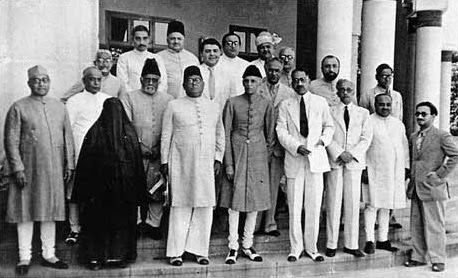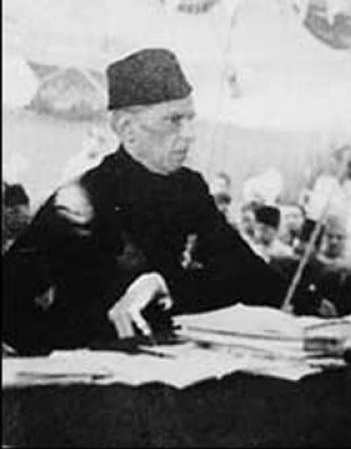Presidential address by Quaid e Azam in March 1940 on the eve of Lahore Resolution
Articles / Stories, History of Sub-continent, Speeches Quaid e Azam Speech Urdu PDF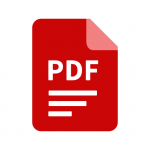
The Pakistan Resolution on 23rd March 1940 in Lahore and The Presidential address by Quaid-e-Azam
The Presidential address by Quaid e Azam Muhammad Ali Jinnah was delivered on 22nd March 1940, on the occasion of the famous Lahore resolution, which is also known as the Pakistan Resolution. The 27th Annual Meeting of the All India Muslim League began at 2:30 pm in March 1940 at Manto Park, Lahore. Only three days before this meeting on March 19, police had opened fire on a gathering of Khaksars and martyred several workers of this organization. The atmosphere in Lahore was mournful, and every effort was made to stop the Muslim League rally. The day was a very important one for the Muslims of the subcontinent. Leaders belonging to the All India Muslim League had arrived in Lahore from all over India to attend the meeting. Many people had also gathered in Lahore from various other parts of India because their beloved Quaid Muhammad Ali Jinnah was about to address them on the land of Punjab. As soon as Quaid-e-Azam arrived in Lahore, he had told the reporters that the League would take a revolutionary step in this meeting. There were various rumors and speculations on his statement. But, no one could reach the bottom of it. The venue for the meeting had a capacity of 60,000 people, but the number of people coming to attend it was much higher. The venue was full ahead of schedule. The Muslim National Guards, dressed in green uniforms, were on guard duty. Those who came later were continued to gather outside the venue. Many loudspeakers were installed for this mammoth crowd. The excitement of the people was palpable. Justice (retd) Aftab Farrukh said that his father Barrister Farrukh Hussain, who had also fought the case of Alam Din Shaheed, was in charge of the venue committee of the meeting, and arrangements for the entire meeting were the responsibility of Mian Amiruddin and Mian Bashir Ahmed. “He was eleven years old and was himself present at the meeting,” Justice (retd) Aftab said. The whole city of Lahore came to this meeting and I was also a part of this flood. Earlier, when the Quaid-e-Azam reached Lahore Railway Station by train on March 21 to attend the rally, the whole of Lahore was there to receive him.|
Pakistan Resolution to Pakistan 1940-1947: A Selection of Documents Presenting the Case for Pakistan Latif Ahmed Sherwani |
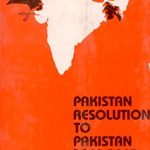 |
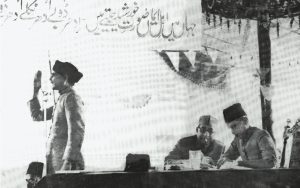
( جہاں میں اہلِ ایماں صورتِ خورشید جیتے ہیں۔ ادھر ڈوبے، ادھر نکلے، ادھر ڈوبے، ادھر نکلے )
The proceedings of the meeting started with the recitation of the Qur’an and thereafter a series of poems and songs began. Anwar Qureshi recited Mian Bashir Ahmed’s poem “Millat ka pasban hai Muhammad Ali Jinnah Nation” for the first time, in a singing voice. Sir Shahnawaz Mamdoot delivered the welcome address in Urdu. Quaid-e-Azam’s speech was in English and was spontaneous which is being presented in PDF docs with Urdu translation. Many people were unable to understand English, but they listened to the long speech of the Quaid-e-Azam with passion and great interest. They expressed loud admiration for some of the phrases. (The same sight was seen in April 1928 when Iqbal gave the first lecture on reconstruction in English at a meeting of the Anjuman-e-Himayat-e-Islam, and those who did not know English explained the reason for the three-hour silence: “It was enough for us that Hazrat Allama Iqbal is present and speaking with the full force of his knowledge and grace in support of the beliefs of Islam. What more do we need than that,” Khurram Ali Shafiq.) Who drafted the Lahore resolution? Some of the writers in the past and some others at present can be seen as how they create controversies about who drafted the resolution. On drafting the resolution, you can find information in print and electronic media in which some attribute it to Sir Sikandar Hayat and some to Sir Zafarullah Khan, while some of them gave its credit to Liaquat Ali Khan. Many other stories are also circulating nowadays days in social media as well. During the last 30 years, a large collection of historical documents and papers related to India’s struggle for independence, the history of Pakistan, and Quaid-e-Azam have come to light. These include Lord Mountbatten Papers, Transfer of Power Volumes, Wavel Journal, Quaid-e-Azam Papers, Shamsul Hassan Collection, All India Muslim League Records, Nishtar Collection, Selected Works of Gandhi, Nehru Papers, Patel Papers, Rajendra Prasad Correspondence, Sapru papers, Selected Works of MN Rai, Jinnah Isfahani Correspondence, Sir Yamin Khan Collection, Mian Abdul Aziz Collection, and Sir Abdullah Haroon Collection are notable. Nawab Syed Shamsul Hassan, Assistant Secretary-General of the All India Muslim League, who has compiled credible documents such as the Shamsul Hassan Collection, has detailed the Pakistan Resolution in one of his articles. Syed Shamsul Hassan was associated with the All India Muslim League as Office Secretary and then Assistant Secretary from 1914 to 1940. After the formation of Pakistan until the enactment of Martial Law in 1958, he was in charge of the Central Secretariat of the Pakistan Muslim League. Syed Sahib’s historical essay was first published in the Daily Morning News on March 23, 1976, in Karachi. This is an authentic and valid testimony of the Lahore Resolution. The Muslim League Working Committee had earlier decided to hold a general meeting in Lahore from December 28 to 30, in 1939, which was later adjourned till March. Syed Shamsul Hassan said: Nawab Liaquat Ali Khan wrote to me from Missouri on August 10, 1939, that I am sending you three constitutional schemes which were prepared by Sir Sikandar Hayat Khan, Dr. Abdul Latif, and Dr. Afzal Hussain Qadri. Please arrange the fifty copies of each to be printed. Once the copies are ready, one copy of each scheme should be sent to each member of the working committee and to the secretary of each provincial league. So, it was sent to the members in which they were asked to study all the schemes carefully so that they could be discussed in the next meeting. Syed Shamsul Hasan further said: (on the occasion of the Lahore meeting) “After formulating the points, the working committee assigned Malik Barkat Ali, Nawab Muhammad Ismail Khan, and Nawabzada Liaquat Ali Khan the task of drafting the resolution. The 1st draft was prepared in about two hours. Malik Barkat Ali prepared the (final) draft in light of 1st draft. The final draft was presented to the working committee that night and it was approved. When the Subject Committee met on March 23 at 10.30 am, it approved the resolution. It should be noted that this subject committee consisted of 25 members. The proceedings of the meeting began on March 23, 1940, at 3 pm The Prime Minister of Bengal AK Fazlul Haq presented the Lahore Resolution and spoke in support of it. Chaudhry Khaliq-uz-Zaman endorsed the resolution and gave a short speech. During the meeting, the resolution was attributed as “Constitutional Resolution” and later the League renamed it the Lahore Resolution. The name “Pakistan” suggested by Chaudhry Rehmat Ali became popular in many circles at that time. The spouse of the late Maulana Muhammad Ali Johar mentioned this resolution in her speech as “Pakistan Resolution.”Apart from Chaudhry Khaliq-ul-Zaman (UP), other leaders who spoke in support of the resolution were included Zafar Ali Khan (Punjab), Sardar Aurangzeb Khan (NWFP), and Sir Abdullah Haroon (Sindh). The meeting resumed at 11:15 am on March 24. In today’s meeting, Khan Bahadur Nawab Mohammad Ismail Khan (Bihar), Qazi Mohammad Issa Khan (Balochistan), Abdul Hamid Khan (Madras), I.I. Chundrigar (Bombay), Syed Abdul Rauf Shah (CP), and Dr. Muhammad Alam delivered speeches in support of the resolution. On this occasion, the Quaid-e-Azam intervened and directed Abdul Rehman Siddiqui to present a resolution on Palestine. Syed Raza Ali and Abdul Hameed Badawi made speeches in support of the resolution, and the resolution was passed immediately. Thereafter the proceedings of the meeting were adjourned till 9 pm. When the meeting started again at night, Quaid-i-Azam presented a resolution of sympathy to the Khaksars on the tragedy of March 19. Following these, Syed Zakir Ali, Begum Muhammad Ali, and Maulana Abdul Hamid delivered speeches in support of the “Constitutional Resolution” after which the resolution was passed unanimously. In continuation of the approval of the resolution, another resolution was passed to amend the constitution of the Muslim League and the officials were chosen. Finally, Quaid-e-Azam invited Nawab Bahadur Yar Jang to deliver a speech, to who Mukhtar Masood had written in his most famous book “Awaaz-e-Dost”, “his speech was sometimes volcanic and sometimes waterfall.”Concluding the meeting, in his concluding remarks, Quaid-e-Azam termed the Lahore meeting as a milestone in the history of Muslim India which found the destiny of Muslims. After which this historic meeting ended at 11:30 pm. Matloob-Al-Hassan Syed, secretary to the Quaid-e-Azam, said that after the resolution was passed, he said, “Iqbal is no longer with us, but if he were alive, he would be happy to know that we did exactly, what he told us to do.”